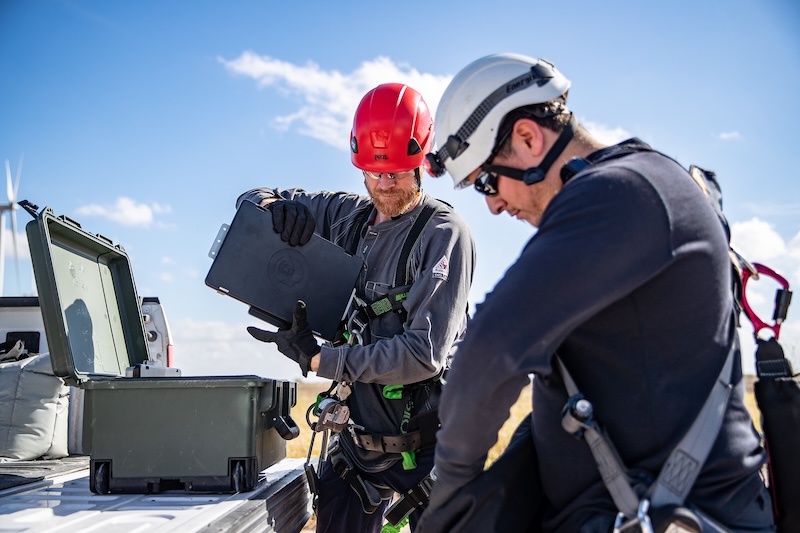An Ultrasonic Acoustic Bat Deterrent System
The wind industry takes pride in advancing a clean energy future while protecting species across the globe from the impacts of climate change. However, no energy solution is without challenges. Wind turbines, for instance, have been shown to cause direct mortality to bats. With bat populations already declining due to habitat loss, diminishing food sources, and disease, the wind industry has diligently sought solutions to mitigate this impact.
%20.jpeg)
Hoary Bat (courtesy Pennsylvania Bat Conservation and Rehabilitation)
One primary strategy has been curtailment — slowing or stopping wind turbine blades during periods of low wind speed. While effective at reducing bat fatalities, curtailment comes with significant costs; by reducing power production, curtailment leads to potential annual energy losses, particularly as wind speed thresholds for curtailment increase. As a compromise between conservation and economic feasibility, the industry has largely adopted a curtailment set point of 5 m/s.
 To address these challenges, turbine-mounted ultrasonic acoustic bat deterrent systems were developed. These systems emit ultrasonic acoustic fields in the same range as bats’ natural echolocation frequencies. This interferes with bats’ ability to receive and interpret their own calls, creating a disorienting airspace that encourages them to avoid treated areas, including the rotor-swept zones of turbines. By effectively “jamming” bats’ echolocation, these deterrents provide a proven method to reduce collisions.
To address these challenges, turbine-mounted ultrasonic acoustic bat deterrent systems were developed. These systems emit ultrasonic acoustic fields in the same range as bats’ natural echolocation frequencies. This interferes with bats’ ability to receive and interpret their own calls, creating a disorienting airspace that encourages them to avoid treated areas, including the rotor-swept zones of turbines. By effectively “jamming” bats’ echolocation, these deterrents provide a proven method to reduce collisions.
Validating the effectiveness of ultrasonic acoustic deterrents
Initial validation of ultrasonic acoustic deterrents has demonstrated their potential in reducing bat mortality at operational wind projects. A study in Illinois compared bat mortality at control turbines, and turbines equipped with ultrasonic acoustic deterrents combined with a 5.0 m/s curtailment. The combined treatment reduced bat mortality by 68 percent, compared to a 43 percent reduction with curtailment alone. This approach significantly improved conservation outcomes for certain species. The Silver-haired bat, for instance, experienced a mortality reduction of 15 percent with curtailment alone, and a 72 percent reduction when deterrents were added, increasing effectiveness by 67 percent. The impact on the Eastern red bat was similarly improved, with mortality reduction increasing to 58 percent from 39 percent, boosting effectiveness by 32 percent.
An additional study in Texas used a randomized block design with 16 turbines. Each turbine alternated nightly between active (deterrent on) and control (deterrent off) conditions. Over two years, the deterrents reduced overall bat fatalities by 50 percent, with notable reductions for both Brazilian Free-tail bats (54 percent) and Hoary bats (78 percent).

Most recently, a landmark six-year study in Ontario assessed bat fatality rates under three scenarios: baseline operations, a 5.5 m/s curtailment, and a 5.5 m/s curtailment paired with ultrasonic acoustic deterrents. When curtailment was combined with deterrents, significant reductions in fatalities per turbine were observed compared to baseline operations. The Big Brown Bat saw the largest reduction (91 percent), followed by the Silver-haired Bat (76 percent), Hoary Bat (75 percent), and Eastern Red Bat (57 percent). Notably, the addition of ultrasonic acoustic deterrents reduced fatality rates by an additional 26-82 percent compared to curtailment alone, depending on the species.
Advancing wind energy development and conservation
The results of these studies, along with the growing adoption of ultrasonic acoustic deterrents by leading wind developers worldwide, underscore their value as a tool for mitigating bat fatalities without increasing curtailment thresholds. With the help of ultrasonic acoustic deterrents, the wind industry can further minimize its impact on bats while enabling more efficient wind energy production — an essential strategy in combating climate change.
Brittany Good is Senior Marketing Specialist at NRG Systems, which allows operators to produce more renewable energy more of the time, keeping bats out of harm’s way while protecting the financial viability of wind projects and maximizing ROI.
NRG Systems | www.nrgsystems.com
Author: Brittany Good
Volume: 2025 July/August








